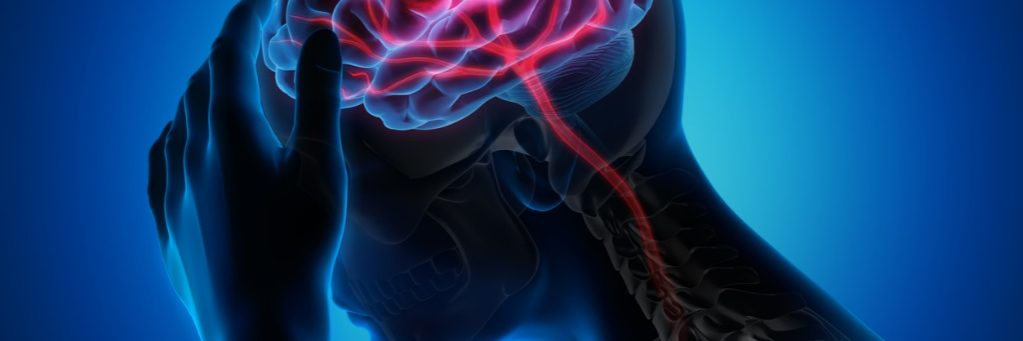Strokes can be very scary. Even just talking about strokes can trigger a great deal of anxiety.
And the effects of a stroke can be life long, and can include complete or partial paralysis and brain injury. This is why it is critical, if you have any warning signs of stroke, to see a doctor immediately.
Why? Because Strokes can be treated, and in many cases strokes can even be prevented. But there is a limited window within which treatment will be effective, so getting medical treatment right away is critical.
How do strokes occur?
A stroke occurs when blood flow through an artery to the brain is cut off either by a blockage or because the artery ruptures and bleeds into the brain tissue. More than 85 percent of strokes are caused by blockage by a blood clot or plaque.
Types of Stroke: hemorrhagic – ischemic – embolic
Hemorrhagic – Bleeding
A hemorrhagic stroke occurs when a blood vessel in the brain ruptures or bursts causing bleeding in the brain. This can put pressure on the brain and compress blood vessels thereby limiting blood flow. Limited blood flow means limited oxygen, and when you don’t get enough oxygen the brain cells can die.
An ischemic stroke occurs when a blood vessel in the brain is blocked. Anything downstream from that blood vessel is not going to get enough oxygen, and the brain cells can die if that blockage isn’t opened up.
An embolic stroke occurs when a blood clot breaks off from somewhere, usually in the heart, and travels to the brain. This will also cause damage, because once that blood clot lodges in the brain it will damage surrounding tissue and brain cells, and decrease blood flow.
ACT FAST: when someone is having a stroke, it is critical to act FAST. The longer it takes to get treatment, the more brain damage will occur. And if you get treatment quickly, not only can you stop the damage, you can actually reverse some of the symptoms and restore/improve function, whether it be speech, memory, or paralysis.
So, what are the potential warning signs of stroke?
F.A.S.T. – Signs of Stroke Should Prompt FAST Action
The American Stroke Association developed this easy-to-remember guide to help identify the signs of a stroke.
F – Face drooping. Is one side of the person’s face drooping or numb? When he or she smiles, is the smile uneven?
A – Arm weakness. Is the person experiencing weakness or numbness in one arm? Have the person raise both arms. Does one of the arms drift downward?
S – Speech difficulty. Is the person’s speech suddenly slurred or hard to understand? Is he or she unable to speak? Ask the person to repeat a simple sentence. Can he or she repeat it back?
T – Time to call 9-1-1. If any of these symptoms are present, dial 9-1-1 immediately. Check the time so you can report when the symptoms began.
In the ER, a quick CT Scan can tell you whether there is bleeding on the brain. If there is bleeding on the brain, in some cases you can drain the bleeding to limit the damage caused by the stroke. In some cases you can give medications to lower your blood pressure and that can improve the outcome.
If there is no bleeding on a CT scan, then you have to assume the symptoms are being caused by a blood clot, and give “Clot Busting” medication or blood thinners.
As long as that treatment is started within 3-6 hours of when the symptoms began you can dissolve the clot and restore function.
Case Examples
Hemorrhagic stroke caused by bleeding in brain:
Several years ago we represented a woman who had a history of high blood pressure. Every doctor knows, or at least should know, that this increases your risk for a bleeding stroke. One day she went to her doctor with a splitting headache. The nurse took her blood pressure and it was 240/160, alarmingly elevated. The doctor said she had to run out to a meeting, and prescribed Advil for her headache.
After our client had a serious stroke, we were able to prove it was preventable and get a favorable result for her at trial.
Ischemic/clot/plaque buildup:
Another client of ours, an elderly woman, saw her doctor on an emergency basis with sudden onset of weakness, tingling and numbness in her left arm. She did her part by going to her doctor. Sadly, the doctor assumed it was caused by a new pinched nerve in her neck, and did no testing and made no referrals to see if there was a stroke.
Unfortunately her arm numbness was being caused by a blocked artery in her brain.
If that woman had had the benefit of clot busting medication the blood clot that was causing that blockage could have been dissolved, and she could have had her arm function restored. Instead, the doctor sent her home with some pain medications, and she ended up wheelchair bound for life.
This was a challenging trial for a lot of reasons, with the defense lawyer pulling every dirty trick in the book, but in the end we were able to prevail for this woman.
If you’ve been suffered from a delayed diagnosis of a stroke, you want an experienced attorney on your side. Bonina & Bonina, PC understand the importance of helping victims of strokes get the help they need for their trauma. Contact us online or call us at 1-888-MEDLAW1 to schedule your free consultation. Home and hospital visits are available. Se Habla Español.

